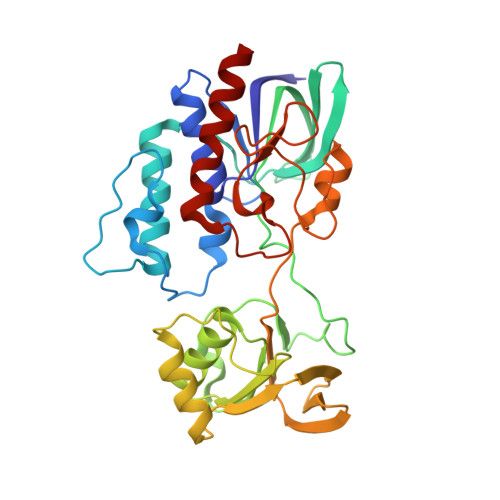The Crystal Structures of Bacillithiol Disulfide Reductase Bdr (YpdA) Provide Structural and Functional Insight into a New Type of FAD-Containing NADPH-Dependent Oxidoreductase.
Hammerstad, M., Gudim, I., Hersleth, H.P.(2020) Biochemistry 59: 4793-4798
- PubMed: 33326741
- DOI: https://doi.org/10.1021/acs.biochem.0c00745
- Primary Citation of Related Structures:
7A76, 7A7B, 7APR - PubMed Abstract:
Low G+C Gram-positive Firmicutes, such as the clinically important pathogens Staphylococcus aureus and Bacillus cereus , use the low-molecular weight thiol bacillithiol (BSH) as a defense mechanism to buffer the intracellular redox environment and counteract oxidative stress encountered by human neutrophils during infections. The protein YpdA has recently been shown to function as an essential NADPH-dependent reductase of oxidized bacillithiol disulfide (BSSB) resulting from stress responses and is crucial for maintaining the reduced pool of BSH and cellular redox balance. In this work, we present the first crystallographic structures of YpdAs, namely, those from S. aureus and B. cereus . Our analyses reveal a uniquely organized biological tetramer; however, the structure of the monomeric subunit is highly similar to those of other flavoprotein disulfide reductases. The absence of a redox active cysteine in the vicinity of the FAD isoalloxazine ring implies a new direct disulfide reduction mechanism, which is backed by the presence of a potentially gated channel, serving as a putative binding site for BSSB in the proximity of the FAD cofactor. We also report enzymatic activities for both YpdAs, which along with the structures presented in this work provide important structural and functional insight into a new class of FAD-containing NADPH-dependent oxidoreductases, related to the emerging fight against pathogenic bacteria.
Organizational Affiliation:
Department of Biosciences, University of Oslo, Section for Biochemistry and Molecular Biology, P.O. Box 1066, Blindern, NO-0316 Oslo, Norway.
















